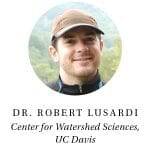A Bridge Runs Through It
Written by Sandra Jacobson, Ph.D., CalTrout South Coast & Sierra Headwaters Regional Director
Southern California is the prism through which endangered species, water supply, transportation, public safety, flood control, residential development, tribal influence, and cultural history converge on the central challenge of maintaining healthy waterways for people and wildlife in urbanized coastal California. The Interstate-5/Metrolink fish passage project on Trabuco Creek in Orange County has all of these wrapped up into a final design package to protect endangered Southern steelhead from extinction. The project embodies the complexities of restoring steelhead migration but also the progress that is being made to enable these native fish to coexist with people in this highly altered landscape.
The fish passage project at the Interstate 5 Bridge Array and Metrolink Railroad Bridge crossing Trabuco Creek addresses one of the most significant fish passage barriers in Southern California. Trabuco Creek is the major tributary to San Juan Creek, designated a high priority Core 1 population in the National Marine Fisheries Services (2012) Southern California Steelhead Recovery Plan.
This fish passage project is regionally unique in that it combines the latest in hydraulic engineering and infrastructure stabilization with restoration of sensitive riverine ecosystems and recreational access. Implementation will restore steelhead access to their historic habitats 15 miles inland to the headwaters. Over the past six years, this project has progressed through conceptual design, alternatives analysis, 65% development of the preferred alternative, physical model testing, and now into final design phase.
A recent article in The Osprey chronicles the challenges and successes of large habitat connectivity projects for sensitive aquatic species that depend on healthy waterways to survive in California. See The Osprey Spring/Summer 2023 issue at here starting at page 15, A Bridge Runs Through It.
Check out 3D Renderings and animation of both fish passage structures in the video below:
I-5 Fish Passage on Trabuco Creek 3D rendering and animation. Project Design Team: Northwest Hydraulics Consultants, Mike Love & Assoc (MLA), Gannett Fleming, Stillwater Sciences. CalTrout, Project Lead. 3D rendering by Travis James, MLA.
It is an art to thread the needle on different missions held by parties directly invested in the outcome through the project. A Cooperative Agreement process is underway, led by CalTrout, involving up to 16 Parties and primarily involving Orange County entities responsible for flood management and mobility. The project is a prime candidate for funding the construction phase through federal Infrastructure Investment and Jobs Act (2022) and the Inflation Reduction Act (2022), which contain large carve-outs for Climate Change solutions.
Metrolink Fish Passage on Trabuco Creek 3D rendering and animation. Project Team and 3D rendering as for I-5 structure.
The Trabuco Fish Passage Project occurs on the traditional lands of the Acjachemen Nation, the Indigenous People who historically inhabited lands that became Orange County, and whose descendants currently reside in Orange County and environs.

We seek to partner with the Acjachemen in all aspects to implement this fundamentally important fish passage project to benefit an endangered species. Domingo Belardes of the Acjachemen Nation joined the USC Student Tour hosted by CalTrout in March 2023 and led us through historical history of the area.


Check out recent article by Francisco Martinezcuello, Public Policy Institute of California (PPIC) CalTrout Ecosystem fellow funded by UC-Davis and CalTrout here.
The fish passage project at I-5 and Metrolink bridges breaks down barriers on many levels not only to restore access and understanding of those that went before us, but to restore our watersheds for those that come after us.

We’ve seen salmon and steelhead rebound in other parts of the country where barriers are removed and habitat is restored. There’s every reason to believe it will also work here.






